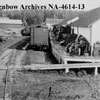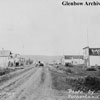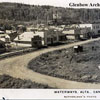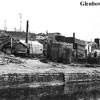Waterways Takes the Lead (1921-1959)

In 1921, the Alberta and Great Waterways Railroad was built along the community of Waterways and soon replaced Fort McMurray as the transportation terminus to the north. Waterways began surpassing Fort McMurray in growth, receiving a wave of immigration. This bustling community soon had a post office, a bank, and the Waterways Hotel, built in 1926. Waterways also became the new steamboat terminal. Meanwhile, Fort McMurray continued to stagnate.
New industries were now centered solely on Waterways. Foremost among these industries was the salt industry. Count Alfred Von Hammerstein returned to the area in the 1920s, and while drilling for oil along the banks of the Athabasca River, he discovered salt. In 1925, he founded the Alberta Salt Company and opened a salt mine on Horse River. Although the mine closed after only three years due to shipping problems, the industry provided a major boost to the economy of Fort McMurray and Waterways.

There were more developments in the Athabasca oil sands during the 1920s. Sidney Ellis of the Dominion Department of Mines successfully drilled and cored oil sands at Mildred Lake in 1926. Soon after, Karl A. Clark, a research council engineer of the Alberta Government, built a tar sands test plant to test oil sands separation. The plant operated from 1929 to 1933, closing partly because of the depression.
The depression of the 1930s did completely destroy the economies of Fort McMurray and Waterways as they depended largely on rail and river transport systems. However, unemployment was high, and residents depended upon home gardens to feed themselves. In 1934, Fort McMurray received a devastating blow when a fire hit Franklin Avenue, the business centre of the hamlet. The fire destroyed 14 businesses, including the hotel and the dance hall. Two years later, a flood submerged parts of Waterways, Fort McMurray and the flatlands between them, known as “the Prairie.” Many homes wiped out forcing residents into a tent town.

Despite these setbacks, the fledgling oil sands industry and salt industry were slowly progressing. Max Ball formed the Canadian Northern Oil Sands Products in 1930, which became Abasands Oil Ltd. In 1935, Abasands constructed a tar sands separation unit at Horse River that opened in 1940; however, the operation was beset with obstacles involving transportation and waste removal. Waterways also benefited from the construction of the Industrial Minerals Salt Co. plant in 1937. The plant was extremely productive, serving markets across Canada and the U.S. until its closure in 1950. The plant provided much of the employment for residents of Waterways.
Fort McMurray and Waterways became busier settlements during the Second World War. An airport opened at Fort McMurray in 1943, which served as an airbase for the Royal Canadian Air Force. Fort McMurray and Waterways were then overtaken by what historians describe as the “American Invasion.” Fort McMurray became a staging area for the U.S. Army’s CANOL project to build a pipeline from Norman Wells to the Whitehorse Refinery. About 3000 American troops were housed in both Waterways and Fort McMurray. Once the pipeline carrying 3000 barrels of oil daily was completed the Americans promptly left while Fort McMurray and Waterways returned to their status as small settlements.

Unfortunately, in the post war era, Waterways and Fort McMurray again stagnated. The Abasand Plant was destroyed by fire in 1945. The Bitumount hot water separation plant built by Can-Amera Oilsands Development and Royalite in 1944 was already failing, suffering from financial and technological problems. On the bright side, the combined population of Fort McMurray and Waterways stood at 1173 in 1946. By amalgamating the next year, they were able to call themselves the Village of McMurray. The “fort” title was dropped as a concession to the community of Waterway. Then on December 30, 1948, McMurray was incorporated as a town.
McMurray’s population changed little in the fifties. In 1956, the population stood at about 1110. Meanwhile, the community of Waterways faltered. Salt was discovered in Unity, Saskatchewan and the salt industry moved there, because of cheaper transportation costs. Thus, in 1950, the Waterways salt plant closed and 50 people were laid off. Next year, the Waterways Hotel, the social hub of the Waterways community, burnt down.
McMurray real estate industry was rather inactive for much of the 1950s. However, groundwork would be laid for unprecedented growth in future decades. During the 1950s, an economically feasible way of extracting the oil from the tar sands was discovered by the Great Canadian Oil Sands, the predecessor to Suncor. The company had been studying the problem of oil extraction since its incorporation in 1953. Other oil companies began acquiring leases on the oil sands regions throughout the decade. Not only had the technology advanced sufficiently to turn a profit, the political climate also warranted exploitation of the tar sands. The Suez Crisis, which heightened tension between the western powers and Egypt, prompted North American governments to look for ways to decrease their oil dependency on the Middle East. Another company interested in the oil sands was a consortium of Royalite, Imperial Oil, City Services, Atlantic Richfield, and Gulf Canada, formed in 1959, the predecessor to Syncrude. Both this consortium and the Great Canadian Oil Sands (GCOS) would dramatically change the face of McMurray, with GCOS building the first oil sands plant in 1967 and Syncrude following with an even bigger oil sands plant in 1978.
References
Alberta Energy and Utilities Board. “Historical Overview of the Fort McMurray Area and Oil Sands Industry in Northeast Alberta.” Earth Sciences Report, 2000-05.
Alberta Government Publicity Bureau Department of Industry and Tourism. Survey of Fort McMurray. 1970.
Alberta Oil Sands Environmental Research Program. History of the Athabasca Oil Sands Region, 1890 to 1960s, Volume 1: Socio-Economic Development. Alberta Environment and Environment Canada: 1980.
“Fort McMurray & Syncrude: An exciting supplement illustrating the dynamic growth of Fort McMurray, marked by the Official opening of the Syncrude Oil Sands Project.” Edmonton Journal, September 18, 1978.
Huberman, Irwin. The Place we call Home: A History of Fort McMurray as its People Remember. Historical Book Society of Fort McMurray: 2001.
Kerri, J. N. “ Fort McMurray: One of Canada’s Resource Frontier Towns.” (MA Thesis) University of Manitoba: 1970.
Update ’83. Fort McMurray Today, Wednesday June 29, 1983.



